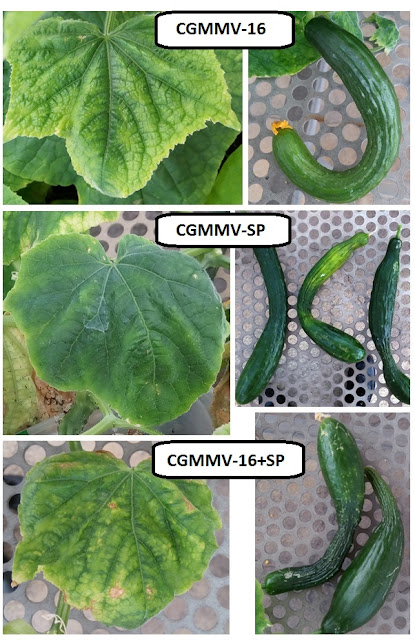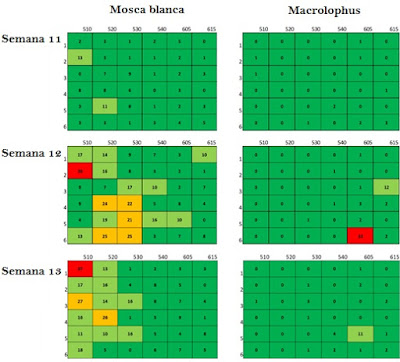Pathology of single and mixed CGMMV-strains infections
Two different strains of cucumber green mottle mosaic
virus: better to be alone than in bad company?
Dirk Janssen, Leticia
Ruiz, IFAPA centro La Mojonera
The
disease caused by cucumber green mottle mosaic virus (CGMMV) was first
described in Spain in the 90s in cucumber crops in the province of Almeria. Since
then there have been several outbreaks of the disease in the area, but
fortunately they ended more or less controlled. For some years now, however,
the incidence and importance of this virus in the area of southeastern Spain
has been increasing, invading locations, such as the province of Granada, where
it had not previously been registered (Ruiz et al., 2018). CGMMV has a range of
horticultural hosts limited to cucurbits and induces symptoms of mosaic,
distortion and blistering on the leaves of affected plants. In the fruits it
causes distortion and mosaic. In watermelon, the virus causes a deterioration
of the pulp with loss of firmness and acquiring a bloody tone (blood flesh disease), and so it loses
its commercial value. The virus is transmitted mechanically and by seed, but
does not attack the embryo. Like other tobamoviruses, CGMMV can survive for a
long time in remains of plant cultures.
In
a paper published in 2017 (Crespo et al., 2017), our virology group from the
IFAPA center of La Mojonera (Almeria, Spain) described for the first time the
appearance in 2015 of a new strain of this virus in greenhouses in Almería and
Granada. This was alarming fact in an intensive horticulture where there are no
cultivars with good resistance to this virus. A phylogenetic analysis
determined that the isolates present in Spain are separated into two groups: a
first group (I) that we call "European" which includes reference
isolates from France, Holland and Uzbekistan, and a second group (II) that call
"Asian" which include samples from Japan, South Korea and Canada.
Thus, we determined for the first time the coexistence in Spain of CGMMV
isolates with different geographical origin (Asian or European) in the same
culture and region, establishing that their difference at a biological level
with respect to the analyzed hosts lies in the appearance of local lesions in
of chlorotic mottle in Chenopodium album
ssp. amaranticolor after mechanical inoculation of a representative number of
isolates belonging to group II; lesions that did not appear in the case of the
inoculated isolates belonging to group I. Finally, a laboratory test was
developed that allowed distinguishing between isolates of group I and II by
analyzing the restriction fragment length polymorphism.
In
a second published article (Crespo et al., 2018), we compared the behavior of
both strains (European and Asian) in different accessions from cucumber
germplasm collections. Both strains cause similar symptoms in the different accessions,
although there may be differences in the accumulation of the virus (viral
load).
It
is difficult to determine the evolution of the disease in crops, in the
presence of the two strains in the same territory. The different interactions
between the Asian and European races could generate different scenarios, either
competing or giving rise to new variants with different genetic
characteristics. This could change the genetic structure of the viral
population and be crucial for the development of efficient and stable control
strategies such as the search for resistances.
But
while this happens or not, we have located greenhouses where both strains are
present in the crops. There has been certain speculation about the effect of
mixed infections of both strains on symptoms caused in plants, specifically if those
mixed infections would cause more severe symptoms than strains separately. These
speculations are based on observations of symptoms and virus detections in
field samples. However, the best way to clarify the doubt is an experimental
trial where the European and Asian strain would be inoculated, separately and
together.
In
controlled facilities of #centroIFAPALaMojonera we have inoculated groups of 5
plants of cucumber cv. Cádiz-RZ with the Asian (CGMMC-16) and European
(CGMMC-SP) strains separately and together in December 2018. Over
time the symptoms were observed. The experiment was completed in February 2019 at
2 months from the beginning, and we observed symptoms of deformation and
mosaic in leaves and fruits in plants infected with CGMMV-16, a deformation and
mosaic similar in leaves but more severe in fruits in the plants infected with
CGMMV-SP. In plants infected with both strains, mosaic deformation and
chlorosis were observed in leaves and severe deformation with very soft mosaic
in fruits (Fig. 1).
Conclusion: based on the results where we observed
symptoms in leaves and fruits, we cannot conclude that the mixed infection with
Asian and European strains is especially more severe, that is, there would be
an effect of synergism. Each strain alone already caused a lot of damage.
References:
Oscar Crespo, Dirk Janssen*, Carmen
Robles, Leticia Ruiz. "Resistance
to Cucumber green mottle mosaic virus in Cucumis sativus". Euphytica,
214:201. DOI:10.1007/s10681-018-2286-0
Oscar Crespo,
Dirk Janssen, Carmen Garcia, Leticia Ruiz (2017) Biological and molecular
diversity of Cucumber green mottle mosaic virus in Spain. Plant Disease. 101: 977-984.
Leticia Ruiz,
Oscar Crespo, Almudena Simón, Carmen Garcia, Dirk Janssen (2018) El virus del
mosaico verde jaspeado del pepino, un viejo conocido y una nueva amenaza.
Phytoma 295: 36-40.
Fig. 1 Symptoms in leaves and fruits of cucumber plants
that were single or mixed infected with CGMMV-16 and CGMMV-SP.




Comentarios
Publicar un comentario